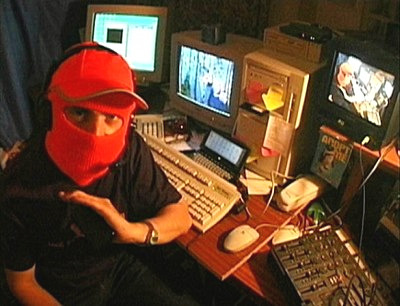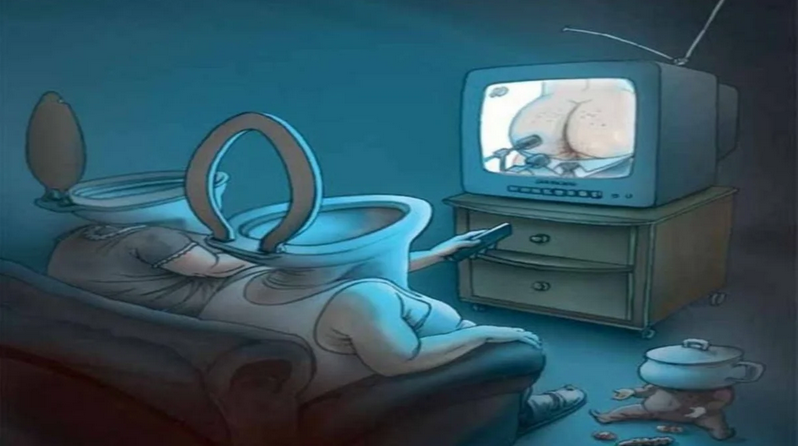Member
- Joined
- Oct 14, 2023
- Messages
- 88
- Thread Author
- #1

Level 99 Paranoid.
BABA-KLAVA (ALWAYS WEAR BALAKLAVA). And right now, they all put on the masks. And they are watching TV Coronavirus, we are all going to die, be afraid, watch, listen to me, and do whatever I say. These televisions are a good tool for controlling the masses. From ZHOPOLIZOR all infa goes to the media, social networks and the Internet.
Then the sundress and the ass begins.

ZOMBO BOX
You do not have permission to view link
Log in or register now.
You do not have permission to view link Log in or register now.
Illuminati Freemasons CIA NSA FSB Russian hackers . Nesting dolls Bears Sweatshirts Balalaikas. This is all bullshit. Compared to what you learn.
This will definitely not be shown on TV))) What a fool would tell fools the truth ..........
The ubiquity of digital television and flat panel televisions is an absolute boon to consumers. But it is possible that the special services will benefit from this much more - these two technologies make it possible to monitor everyone. Right at his house!
In the late 1990s, television began to gradually lose ground in front of the aggressively advancing Internet. Television companies were baffled by the future loss of advertising revenue and wondered what alternative to offer their subscribers. But they had nothing special to oppose to the world wide web.
[/LIST]
Popular websites could operate with such a trump card as contextual thematic advertising, flexible and automatically adapting to the interests of the user, based on the history of his search queries, while when displaying advertisements, TV channels could focus only on the "average" subscriber, information about which was obtained from sociological research.
Of course, it was possible to conduct additional research of the television audience, finding out the preferences by channel, topic, time of day, etc. Usually, for such research, a certain number of people are randomly chosen who agree to be "guinea pigs", and equipment is installed in their house. tracking the data you want.
With the advent of digital television (in particular, IPTV), this task has become even easier - it has become possible to track the data on the corresponding servers of providers. However, to show contextual thematic advertising, TV companies needed extremely unusual information - in particular, what exactly people are doing at the very moment when they are watching TV.
Do they prepare breakfast while doing this?
Do you watch the program before going to bed while lying in bed? Do they dress in front of the mirror in the morning, watching the news on the screen out of the corner of their eye? And what was required was not just "averaged" data (even if based on studies of hundreds of thousands of people), but about each - yes, about each! - to the subscriber.
Unsolvable problem:
With this seemingly insoluble problem, representatives of the television broadcasting company NeoBroad turned to the American research corporation FICTUM (Factual Integrated Collection and Trends Unification Methods), which specialized in such tasks.
The research department of the corporation (Department of Advanced Concepts, DAC) at that time was headed by the legendary Canadian with French roots - Dr. Nicolas Pannier, who worked for a long time in the bowels of the American military-industrial complex.
The original idea of FICTUM engineers was very simple - it was to install video cameras in all TVs. However, such a "head-on" solution to the problem was almost immediately abandoned (at that time, cameras were still quite expensive and not too compact, and it was a question of integrating a camera into every TV, that is, about hundreds of thousands or even millions of pieces!) ...
And then Nicolas Pannier, who for many years has been developing stealth aircraft and phased radars in American defense companies, put forward a brilliant idea. He suggested using the TV screen itself for collecting data.
On the other side of the screen:
“It is known that almost any speaker can work as a microphone,” recalls Nicolas. - So I thought: why can't you make the screen work like a camera sensor? After all, light-sensitive semiconductor elements - transistors that control the matrix - are already located under the layer of liquid crystals.
When light hits them from outside, get a response. "It was in this direction that Panier's group began to work - scientists were engaged in registering a change in the control signal supplied to the transistors of the active matrix, depending on the distribution of the screen illumination outside.
The research took six months. After that, Panier's group was faced with another almost unsolvable task - it was required to decipher the data obtained. The TV screen is not equipped with any optical systems, so there could be no question of any "image". Here Panier was helped by his past experience: after all, the phased antenna array (PAR) of the radar also does not have focusing systems.
Taking as a basis the algorithms for restoring the radar signal, Panier had already by 2000 built a prototype of a system capable of "spying" on what is happening in front of the TV screen. Moreover, this did not require any hardware intervention in the TV circuit - the solution worked at the level of firmware (firmware) of an STB set-top box (Set Top Box, cable TV decoder) and a TV, which could be updated remotely via the network at the operator's command (data on the provider received the TV model from STB to select the appropriate firmware).
After that, the operator could see a rather blurry image of what was happening in the subscribers' homes, as long as the TV was turned on. With plasma panels, everything turned out to be simpler: in order to save screen resource, manufacturers equipped them with light sensors to automatically adjust brightness and contrast. By modifying the image (invisible to the human eye), removing the signal from the light sensor, it was possible to restore a picture of the situation in the room with a sufficiently high resolution.
All-seeing eye.
In 2001, these two technologies, combined under the name Omniscience ("Omniscience"), received a patent with the formula "Method of image reconstruction by recording the intensity and phase of reflected modulated radiation of a distributed two-dimensional set of light-emitting elements ".
However, after reviewing the research results, the NeoBroad company did not dare to use the Omniscience technology. Firstly, the management of the TV company was afraid that this would be regarded by subscribers as an intrusion into their privacy, and secondly, for the purposes of TV broadcasters, "spying" on the subscriber was useless - after all, you cannot put a lot of operators who determine what they are doing at the moment subscriber!
[/LIST]
To define the "context" automation was necessary, which required a hefty financial investment. For the same reasons, other TV companies also showed no interest in the new technology. But she was interested in those who are called "knights of the cloak and dagger" - the special services.
